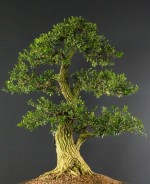 There are over 40 kinds of boxwood, most of which are varieties of English boxwood, Buxus sempervirens. Japanese boxwood (B. microphylla) is also a good choice for bonsai but Buxus harlandii is best because of its small leaves, attractive fissured cork-like bark, and relative tolerant of warm indoors conditions. It is not hardy, however, and must be taken indoors when temperatures fall below 40F. The natural growth habit of boxwood makes it a good subject for the informal upright style.
There are over 40 kinds of boxwood, most of which are varieties of English boxwood, Buxus sempervirens. Japanese boxwood (B. microphylla) is also a good choice for bonsai but Buxus harlandii is best because of its small leaves, attractive fissured cork-like bark, and relative tolerant of warm indoors conditions. It is not hardy, however, and must be taken indoors when temperatures fall below 40F. The natural growth habit of boxwood makes it a good subject for the informal upright style.
Position: Place in brightly lighted cool location ( 37-50 degrees), avoiding direct sunlight in summer. B. harlandii will tolerate temperatures up to 86 F but will need misting twice a day. If the plant is put outside during the summer, be sure to bring it indoors when temperatures drop below 40F.
.
Water: Boxwood do not like wet feet. Remove any water in the saucer and allow the soil to dry out between waterings.
Fertilizer: Feed with bonsai fertilizer every 20-30 days from spring through fall. Do not feed in winter.
Repotting: Repot the plant in spring every 2-3 years being sure prune the roots and add some ground limestone to the soil
Soil: Bonsai soil or soil, peat moss, and sand in a ration of 2:1:2; Boxwood does not tolerate acid soil so add some ground limestone.
Pruning: Pruning the branches can be done at any time. When six pairs of leaves have developed, cut new shoots back to two or three pairs of leaves. Roots should be pruned in spring at the time of repotting.
Wiring: Wiring can be done any time of year.
Propagation: Well ripened cuttings in late summer
